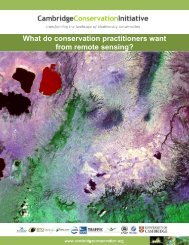CONSERVING BIODIVERSITY & DELIVERING ECOSYSTEM SERVICES
conserving biodiversity & delivering ecosystem services
conserving biodiversity & delivering ecosystem services
You also want an ePaper? Increase the reach of your titles
YUMPU automatically turns print PDFs into web optimized ePapers that Google loves.
In Nepal, the majority of the<br />
population lives in rural<br />
areas and derives its<br />
livelihood directly from<br />
ecosystems services.<br />
Understanding, assessing<br />
and monitoring ecosystem<br />
services can lead to better<br />
policy formulation, resulting<br />
in management that<br />
delivers more effective<br />
conservation, resilient<br />
livelihoods and poverty<br />
reduction.<br />
<br />
In Nepal, the majority of the population derive their livelihoods from natural habitats, such as<br />
forests, grasslands and wetlands (see box).<br />
The importance of ecosystem services to Nepal’s national economy<br />
■ More than 80% of Nepalese people derive their livelihoods from natural habitats<br />
■ Biomass provides nearly 90% of total energy consumption<br />
■ Water crisis has emerged as a national problem<br />
■ Environmental health costs associated with poor environmental management are a<br />
significant burden on the national economy<br />
Despite our dependence on ecosystem services, they are consistently overlooked and<br />
undervalued in decision-making that affects their provision. This may be because ecosystem<br />
services are not understood, or they are taken for granted, or because they are not included in<br />
economic equations when key decisions on land use are made. As a result, poor choices are<br />
often made which destroy or degrade natural habitats, resulting in the decline of many<br />
services, along with the biodiversity that supports them, often with severe impacts on poor<br />
and vulnerable people. Understanding, assessing and monitoring ecosystem services can lead<br />
to better policy formulation, resulting in land-use and management options that deliver more<br />
effective conservation, resilient livelihoods and poverty reduction (see box).<br />
Measuring and monitoring ecosystem services can:<br />
■ lead to better land-use planning decisions to support both biodiversity<br />
conservation and ecosystem service delivery<br />
■ identify and inform management strategies to enhance economic sustainability<br />
and human well-being<br />
■ provide information on additional benefits from business-as-usual approaches to<br />
biodiversity conservation<br />
■ identify those affected by land use management decisions, and so help spread the<br />
costs and benefits more fairly among stakeholders<br />
■ provide information to raise awareness and build public and Government support<br />
for evidence-based policy and management decisions<br />
Wood harvested from forests and other ecosystems has considerable value for many Nepalese people<br />
who use it in cooking and heating their homes (David Thomas)




